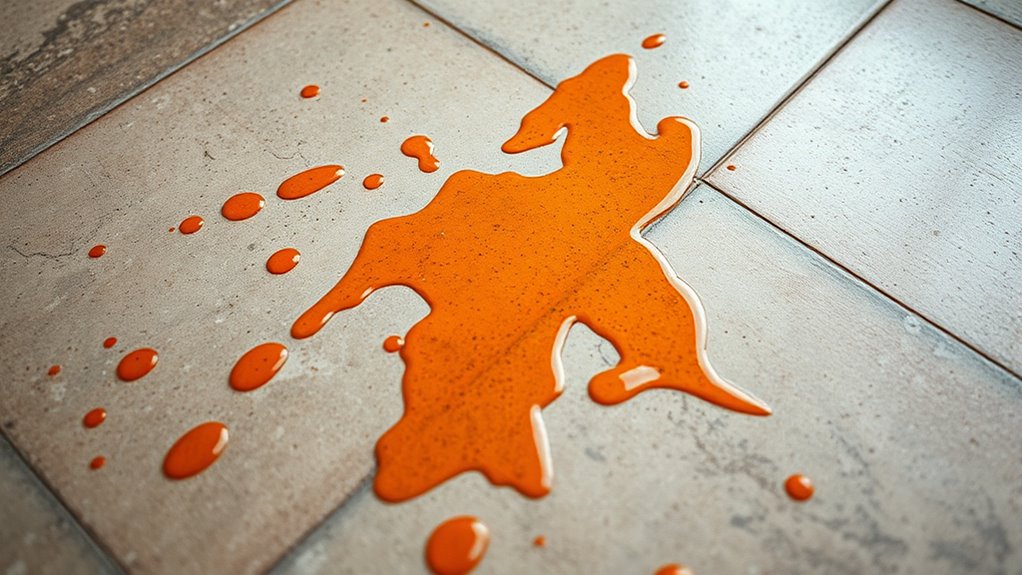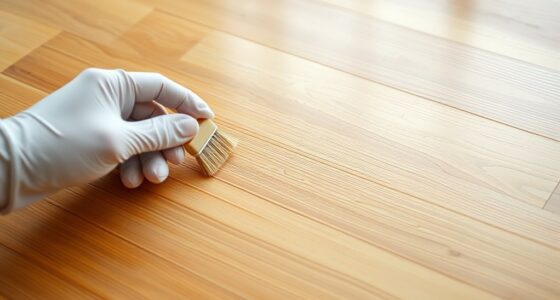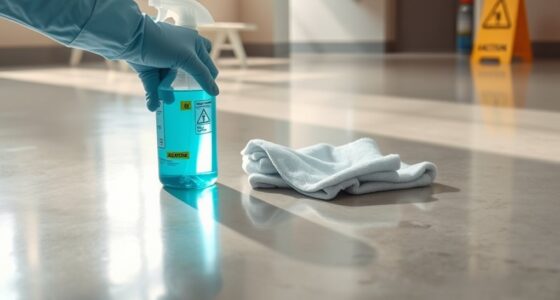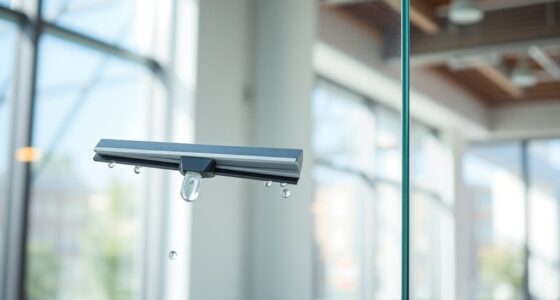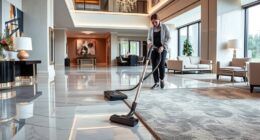When pet messes happen on natural stone, act quickly to blot the spill with a clean, damp cloth to absorb moisture without rubbing. Use a gentle, pH-neutral cleaner safe for your stone to remove the stain and odor. Applying a proper sealant creates a barrier that makes future messes easier to clean and helps prevent lasting damage. Keep your surfaces protected by following best practices—continue to discover how to keep your stone pristine and odor-free.
Key Takeaways
- Act quickly by blotting the pet mess with a clean, damp cloth to prevent stains and odors from setting in.
- Use a mild, pH-neutral stone-safe cleaner to thoroughly clean the affected area, avoiding harsh chemicals.
- Apply a baking soda paste as a gentle deodorizer and abrasive for stubborn stains; rinse thoroughly afterward.
- Seal natural stone surfaces properly with a sealant suited for your stone type to create a stain-resistant barrier.
- Regularly reseal the stone and promptly clean pet messes to maintain surface integrity and prevent long-term damage.
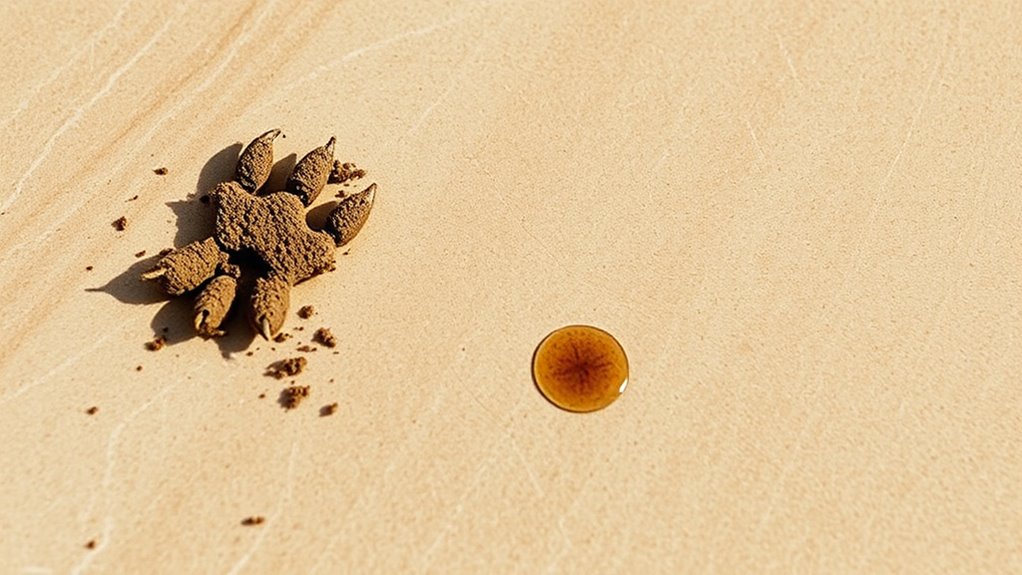
Natural stone surfaces add beauty and durability to your home, but they can be vulnerable to pet messes. When accidents happen, quick and effective pet stain removal is essential to protect your investment and keep your space looking its best. The key is to act fast, using methods that are safe for your natural stone and effective against odors. Avoid harsh chemicals that can damage the surface or leave harmful residues; instead, opt for gentle, pH-neutral cleaners designed specifically for natural stone. Blotting the stain immediately with a clean cloth helps prevent it from seeping deeper into the porous surface. Never rub, as this can spread the mess and cause scratches. Once you’ve absorbed the initial mess, clean the area with a mild stone-safe cleaner, ensuring you don’t leave behind soap or residue that could attract dirt or cause discoloration. For stubborn stains, a mixture of baking soda and water can act as a gentle abrasive and deodorizer. Apply a paste, let it sit briefly, then gently wipe away with a damp cloth. Remember, always rinse thoroughly afterward to prevent any residue from settling into the stone.
Additionally, keeping up with automation technologies in home maintenance can help monitor your natural stone surfaces for early signs of damage or stains, making cleanup easier and more efficient. Proper sealing also plays a vital role in protecting your surfaces from future pet accidents. Proper sealing creates a barrier that makes the stone less porous, reducing the likelihood of stains setting in and making pet stain removal easier next time. Regular resealing, ideally once a year or as recommended by your stone supplier, keeps this barrier intact. This simple step can save you a lot of hassle, preventing long-term damage and discoloration caused by pet messes. When sealing your natural stone, ensure the product is specifically formulated for the type of stone you have—whether marble, granite, or limestone. Follow the manufacturer’s instructions carefully for the best results, and always ensure the surface is thoroughly cleaned and dry before applying the sealant. Proper sealing combined with prompt pet stain removal can extend the lifespan of your natural stone surfaces and keep them looking pristine.
Frequently Asked Questions
Can Natural Stone Surfaces Be Disinfected Without Damage?
Yes, you can disinfect natural stone surfaces safely by using pet-friendly disinfectants that won’t damage the stone. Always guarantee the surface is properly sealed, as sealing protects against stains and harm. Use gentle, non-acidic cleaners designed for natural stone, and avoid harsh chemicals. Regular cleaning with these disinfectants keeps your stone surfaces hygienic without risking damage, allowing you to maintain a clean, safe environment for your pets.
Are There Specific Cleaning Products to Avoid on Natural Stone?
Imagine using harsh chemicals or abrasive cleaners on your natural stone, and it etches or dulls the surface. You should avoid products containing bleach, ammonia, or vinegar, as they can damage your stone. Always opt for pH-neutral, stone-safe cleaners. For example, a homeowner learned the hard way when bleach stained their marble countertop. Stick to gentle, natural cleaning solutions to keep your stone looking pristine.
How Often Should I Reseal Natural Stone After Pet Accidents?
You should reseal your natural stone every 1 to 2 years, especially after a pet accident. The sealing frequency depends on the stone’s porosity and how often accidents happen. If you notice stains or water absorbs quickly, it’s time to reseal. Regular resealing helps protect against future pet accidents, keeping your stone looking great and preventing damage. Stay proactive to maintain your natural stone’s beauty and durability.
Is It Safe to Use Steam Cleaners on Natural Stone?
Using a steam cleaner on natural stone isn’t recommended because steam cleaner risks include potential damage to the stone, such as natural stone corrosion. The high heat and moisture can weaken the surface or cause discoloration. To keep your stone safe, avoid steam cleaning and opt for gentle, pH-neutral cleaners. This approach helps prevent damage and preserves the integrity of your natural stone surfaces.
What Are Signs of Stone Damage From Pet Messes?
Surprisingly, your natural stone might show signs of pet mess damage in subtle ways. Look for stone etching, which dulls the surface, or surface discoloration that can seem like a stain but is actually damage from acids in pet waste. These signs indicate the protective sealant is compromised, risking further harm. Act quickly with gentle cleaning to prevent irreversible damage, even if your pet’s mess seems harmless at first glance.
Conclusion
Now that you know how to handle pet messes on natural stone, you can confidently clean with care, avoiding stains and smells. By acting swiftly, you prevent stubborn spots and preserve your stone’s shine. Remember, a quick, quiet cleanup keeps your space spotless and smelling fresh. Stay savvy, stay safe, and enjoy your serene, stain-free sanctuary—simply by staying sharp, swift, and spotless with every spill.
